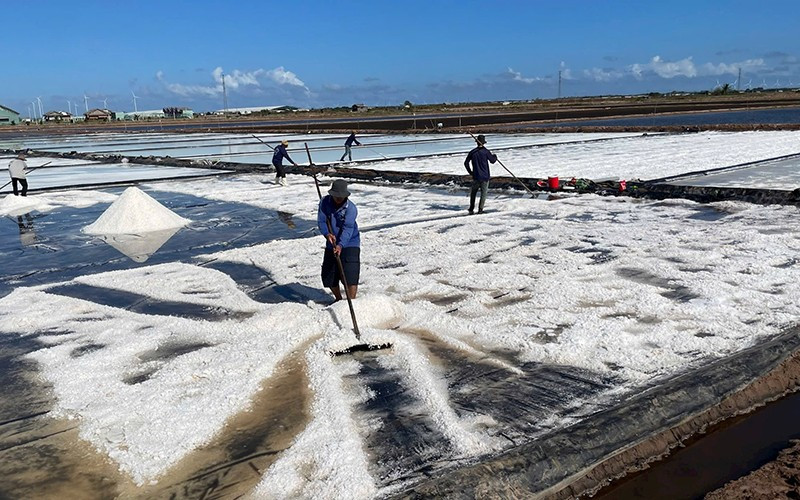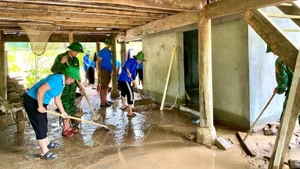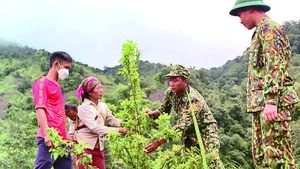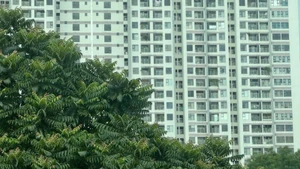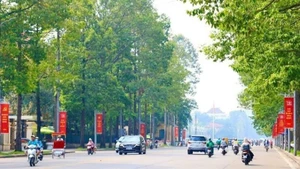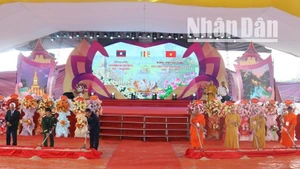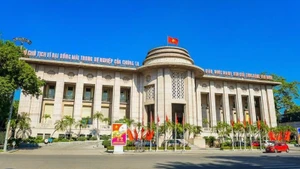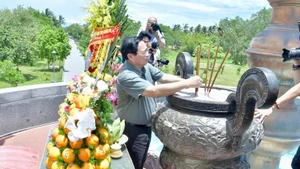The former salt capital
In the early days of the 2025 lunar new year, which coincides with the peak season for salt production and harvesting, we returned to the coastal areas of Vinh Thinh Commune in Hoa Binh District and Long Dien Dong Commune in Dong Hai District - areas still known as the salt-making capital of Bac Lieu Province.
In 2013, Bac Lieu’s salt products received geographical indication protection certification from the Intellectual Property Office under the Ministry of Science and Technology. Notably, in late 2020, Bac Lieu’s salt-making craft was recognised as a national intangible cultural heritage by the Ministry of Culture, Sports and Tourism.
The salt-making trade in Bac Lieu dates back to the early 20th century. At its peak, the salt-making area along Bac Lieu’s coastline stretched 56 kilometres, from Vinh Trach Dong Commune in Bac Lieu City to Ganh Hao Town in Dong Hai District, employing tens of thousands of workers. The Bac Lieu salt industry formerly made significant contributions to the province’s economic growth while carrying cultural value intrinsically linked to the lives of thousands of salt workers in coastal areas, with expertise passed down through generations.
Bac Lieu salt is renowned for its high quality, with salt crystals possessing a pure saltiness without bitterness. Bac Lieu remains one of the country’s largest salt-producing regions. According to preliminary data, in 2024, the province had nearly 800 households with over 1,500 workers in salt production.
However, in recent years, Bac Lieu’s salt industry has faced significant challenges, including complete dependence on weather conditions, labour-intensive work, low salt prices, and price fluctuations during abundant harvests. Consequently, the province now has only about 2,000 hectares dedicated to salt production, with an estimated annual yield of 15,000 to 20,000 tonnes of crystallised salt.
Working together to preserve the traditional craft
“Although salt-making is incredibly laborious, it has been intrinsically linked to my family and many local households for nearly 100 years, spanning multiple generations of salt makers. Therefore, despite the hardships, we persist in maintaining the craft”, shared Ho Van Nien, a renowned salt maker from Long Dien Dong Commune.
Similarly, Phan Chi Tam, who has devoted many years to salt-making in this region, is locally dubbed the “salt king”. Tam recounted: “Salt-making is an extremely demanding work, but sadly, salt prices have been low and unstable for many years. In some years, we couldn’t sell our salt, which forced many households to reluctantly abandon the trade... We simply hope that central government ministries and local authorities can find solutions to stabilise salt prices at reasonable levels to ease the salt workers’ hardships. Only then can we preserve and restore this craft.”
 |
| Making salt is a laborious job. (Photo: Thanh Cuong) |
According to salt workers in Bac Lieu’s coastal region, salt production occurs annually during the dry season, which typically runs from the tenth to the fourth lunar month. The production process here has evolved through generations, with fundamental techniques still maintained and applied as essential requirements, from water collection and storage to increasing salinity levels, crystallisation and harvesting.
According to Tran Van Thua, Chairman of the Doanh Dien Aquaculture Service Cooperative in Dien Hai Commune, the cooperative currently has 76 members, with nearly 70 hectares dedicated to salt production. Currently, the cooperative employs both traditional salt production methods, where water is allowed to settle directly on earthen beds for salt crystallisation, and a newer method using plastic tarpaulin to produce purer white salt. Compared to traditional salt, salt produced using the new method commands a premium of 400-500 VND per kilogramme and is more suitable for export.
In addition to salt production, the Doanh Dien Cooperative also produces artemia (larvae used as feed in shrimp and fish hatcheries). In 2024, favourable weather conditions led to a successful artemia harvest, yielding approximately 100 million VND per hectare annually. Salt production alone generates profits of 40-50 million VND per hectare per year.
“However, the greatest concern for our more than 70 cooperative members and hundreds of salt-producing households in Bac Lieu’s coastal region remains the recurring pattern of good harvests but poor prices”, said Thua.
Luu Hoang Ly, Director of the Bac Lieu Department of Agriculture and Rural Development, noted that the province’s salt production area using tarpaulin remains very limited, accounting for less than 10% of the total salt-producing area. To further promote conversion to a new production model, the province has implemented various support policies, including a project on enhancing the value of salt production for the 2021-2030 period, aiming not only to improve productivity and quality but also to diversify salt products, meet domestic demand and target exports.
To date, Bac Lieu has established two salt processing factories with a combined annual capacity exceeding 36,000 tonnes. The investment in technology, such as salt drying machines by Bac Lieu Salt Joint Stock Company, has helped enhance product value. The bright white salt crystals, uniform in size with a refined saltiness, have reached demanding markets, including Japan, the Republic of Korea, and several regional countries.
To honour and preserve the salt-making craft, Bac Lieu Province, in collaboration with the MARD, is organising the first national salt festival, scheduled for March this year. The festival is expected to feature approximately 100 booths showcasing salt products, OCOP products, salt-tourism combination products, salt production and processing cooperatives, and equipment and technology, along with conferences, seminars, and trade and investment promotion activities.
This event provides an opportunity to connect producers and businesses, creating momentum for the salt industry’s sustainable development while also inspiring love for the traditional craft among younger generations and attracting skilled labour to salt production and trading. Through the festival, the province hopes to promote the salt industry’s potential to improve salt workers’ lives and get rich from this “white gold” resource.
